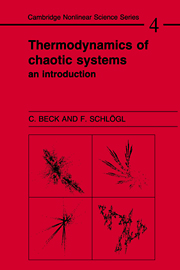Book contents
- Frontmatter
- Contents
- Preface
- Introduction
- PART I ESSENTIALS OF NONLINEAR DYNAMICS
- PART II ESSENTIALS OF INFORMATION THEORY AND THERMODYNAMICS
- PART III THERMOSTATISTICS OF MULTIFRACTALS
- 9 Escort distributions
- 10 Fractals
- 11 Multifractals
- 12 Bit-cumulants in multifractal statistics
- 13 Thermodynamics of finite volume
- PART IV DYNAMICAL ANALYSIS OF CHAOTIC SYSTEMS
- PART V ADVANCED THERMODYNAMICS
- References
- Index
10 - Fractals
Published online by Cambridge University Press: 14 September 2009
- Frontmatter
- Contents
- Preface
- Introduction
- PART I ESSENTIALS OF NONLINEAR DYNAMICS
- PART II ESSENTIALS OF INFORMATION THEORY AND THERMODYNAMICS
- PART III THERMOSTATISTICS OF MULTIFRACTALS
- 9 Escort distributions
- 10 Fractals
- 11 Multifractals
- 12 Bit-cumulants in multifractal statistics
- 13 Thermodynamics of finite volume
- PART IV DYNAMICAL ANALYSIS OF CHAOTIC SYSTEMS
- PART V ADVANCED THERMODYNAMICS
- References
- Index
Summary
Fractals are complex geometrical objects that possess nontrivial structure on arbitrary scales. In this chapter we first describe a few examples of fractals with a simple recurrent structure. Starting from these simple examples we explain the concept of a ‘fractal dimension’ and ‘Hausdorff dimension’. Finally, we consider some more complicated examples of fractals that are of utmost interest in nonlinear dynamics, yielding a glimpse of the beauty inherent in ‘self-similar’ structures: these are the Mandelbrot set, Julia sets, and fractals generated by iterated function systems.
Simple examples of fractals
The Koch curve A standard example of a fractal is the so called ‘Koch curve’. It is constructed as follows. We start with an equilateral triangle with sides of unit length and divide each side into three equal parts. Then, as illustrated in fig. 10.1, we put onto the middle part of each side a smaller equilateral triangle with a third of the side length. This step is then repeated for each of the new sides that were generated in the preceding step. The figure that arises after an infinite number of steps is the famous ‘Koch island’. Its border is called the ‘Koch curve’. It does not possess a finite length nor a tangent at any point. In contrast to the smooth lines and curves of Euclidean geometry such a geometric creation is called a ‘fractal’.
Let us use the following procedure to measure the length of the Koch curve or of an irregularly shaped coastline of an island.
- Type
- Chapter
- Information
- Thermodynamics of Chaotic SystemsAn Introduction, pp. 94 - 113Publisher: Cambridge University PressPrint publication year: 1993

